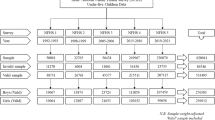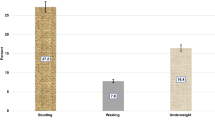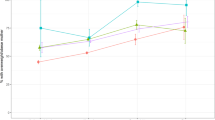Abstract
Objective: To propose a method to assess patterns of intra-familiar distribution of undernutrition and apply it to different socioeconomic strata of the Brazilian population.
Design: A large nationally representative cross-sectional anthropometric survey undertaken in 1989 is the primary source of information. Undernutrition was defined as body mass index (adults) and weight-for-age (children) below the 5th percentile of a healthy and non-malnourished reference population. Log-linear models were used to assess patterns of intra-familiar distribution of nutritional status in four income strata.
Subjects: Two thousand, one hundred and seventy-four families composed by at least one child 6–36 month-old and his/her father and mother.
Setting: All regions in Brazil.
Results: Undernutrition was significantly associated among household members only for the 25% poorest families (P<0.0001). In this group, the presence of undernutrition in the mother or the father increased 1.6–1.9 times the risk of undernutrition in the child and the presence of undernutrition in the father made it 2.7 times more frequent in the mother. The relatively small prevalence ratios suggest that even in extremely poor families only a small proportion of undernutrition could be attributed to common household determinants.
Conclusion: Our results are consistent with the hypothesis that in transitional societies undernutrition would appear as a global family problem only for those at the earlier stages of the nutrition transition. Policies and strategies to overcome undernutrition should take this fact into account.
Sponsorship: Grants from FAPESP (Fundação de Amparo à Pesquisa do Estado de São Paulo) and CNPq (Conselho Nacional de Desenvolvimento Científico e Tecnológico).
This is a preview of subscription content, access via your institution
Access options
Subscribe to this journal
Receive 12 print issues and online access
$259.00 per year
only $21.58 per issue
Buy this article
- Purchase on Springer Link
- Instant access to full article PDF
Prices may be subject to local taxes which are calculated during checkout
Similar content being viewed by others
Author information
Authors and Affiliations
Rights and permissions
About this article
Cite this article
Monteiro, C., Mondini, L., Torres, A. et al. Patterns of intra-familiar distribution of undernutrition: methods and applications for developing societies. Eur J Clin Nutr 51, 800–803 (1997). https://doi.org/10.1038/sj.ejcn.1600458
Received:
Revised:
Accepted:
Issue Date:
DOI: https://doi.org/10.1038/sj.ejcn.1600458
Keywords
This article is cited by
-
Relationships between undernutrition prevalence among children and adult women at national and subnational level
European Journal of Clinical Nutrition (2005)



